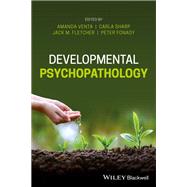The difference between a DP approach and more traditional descriptive psychiatric approaches represented in Child Psychopathology textbooks is clear. The DP approach goes beyond the mere “what” of psychopathology (description of the phenomenology, etiology and epidemiology) to include the “how” of psychopathology. How does normal development go awry? What are the factors (mechanisms) that determine the multiple pathways that may lead to psychopathology in one child, but not another? Because of the focus on “how”, the DP approach has over the last 20 years become the guiding framework for understanding psychopathology in children and adolescents. Courses both at the undergraduate and graduate levels are being renamed from “Child Psychopathology” or “Abnormal Child Psychology” to “Developmental Psychopathology”. Yet, few textbooks have been created to guide teaching of DP courses at the upper undergraduate level.

Developmental Psychopathology
by Sharp, Carla; Fonagy, Peter; Fletcher, JackBuy New
Rent Textbook
Rent Digital
Used Textbook
We're Sorry
Sold Out
Summary
Author Biography
Carla Sharp, PhD is an Associate Professor of Psychology and Director of the Developmental Psychopathology Lab, University of Houston, Texas, USA, where she also leads the Adolescet Diagnosis Assessment Prevention and Treatment (ADAPT) Clinic.
Peter Fonagy, PhD, FBA is Freud Memorial Professor of Psychoanalysis and Head of the Research Department of Clinical, Educational, and Health Psychology at University College London, UK, and Chair of the Postgraduate Centre of the International Psychoanalytic Association.
Jack M. Fletcher, PhD is Hugh Roy and Lillie Cranz Cullen Distinguished Professor, Associate Vice President for Research Administration, and Associate Chair of the Department of Psychology at the University of Houston, Texas, USA.
Table of Contents
Part I: Background
Chapter 1. Traditional Approaches to Psychopathology
Chapter 2. Developmental Psychopathology
Chapter 3. Normal Development
Chapter 4. Insecure Attachment
Part II: Problems Emerging in Childhood
Chapter 5. Learning Difficulties
Chapter 6. Attention Deficit Hyperactivity Disorder
Chapter 7. Autism Spectrum Disorder
Chapter 8. Emergence of Antisocial Behavior in Middle Childhood
Chapter 9. Fear and Anxiety
Part III: Problems Emerging in Adolescence and Young Adulthood
Chapter 10. Depression and Suicide
Chapter 11. Eating Disorders
Chapter 12. Substance Use Disorders
Chapter 13. Schizophrenia
Chapter 14. Emerging Personality Disorder
Part IV: Special Topics & Future Directions
Chapter 15. Maltreatment
Chapter 16. Divorce, Separation, and Loss
Chapter 17. Quo Vadis
An electronic version of this book is available through VitalSource.
This book is viewable on PC, Mac, iPhone, iPad, iPod Touch, and most smartphones.
By purchasing, you will be able to view this book online, as well as download it, for the chosen number of days.
Digital License
You are licensing a digital product for a set duration. Durations are set forth in the product description, with "Lifetime" typically meaning five (5) years of online access and permanent download to a supported device. All licenses are non-transferable.
More details can be found here.
A downloadable version of this book is available through the eCampus Reader or compatible Adobe readers.
Applications are available on iOS, Android, PC, Mac, and Windows Mobile platforms.
Please view the compatibility matrix prior to purchase.
